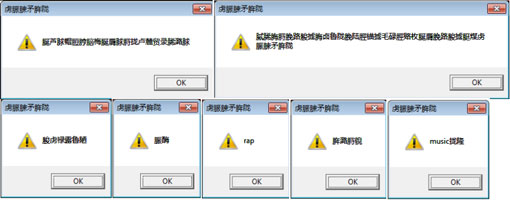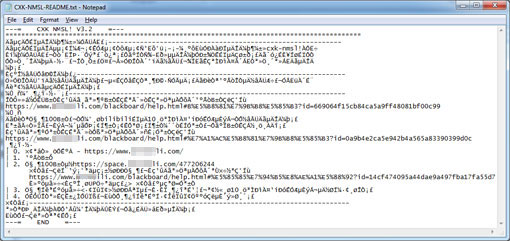Ransom.BAT.CRYPENCODE.A
Trojan.BAT.Ransom (IKARUS), Trojan.BAT.36400 (QUICKHEAL)
Windows


Threat Type: Ransomware
Destructiveness: No
Encrypted: No
In the wild: Yes
OVERVIEW
Dropped by other malware, Downloaded from the Internet
This Ransomware arrives on a system as a file dropped by other malware or as a file downloaded unknowingly by users when visiting malicious sites.
It executes then deletes itself afterward.
It encrypts files found in specific folders. It drops files as ransom note.
TECHNICAL DETAILS
7,427,407 bytes
BAT
No
24 Feb 2020
Drops files, Displays message/message boxes
Arrival Details
This Ransomware arrives on a system as a file dropped by other malware or as a file downloaded unknowingly by users when visiting malicious sites.
Installation
This Ransomware drops the following files:
- %System Root%\x
- %System Root%\krnln.fnr
- %System Root%\CXK-NMSL-DATA.exe
- %System Root%\x.js
- %System Root%\x.vbs
- %User Temp%\录娄脛茫脤芦脙脌.mp3
- %Application Data%\wallpaper.jpg
- %System Root%\z.zip
(Note: %System Root% is the Windows root folder, where it usually is C:\ on all Windows operating system versions.. %User Temp% is the current user's Temp folder, which is usually C:\Documents and Settings\{user name}\Local Settings\Temp on Windows 2000(32-bit), XP, and Server 2003(32-bit), or C:\Users\{user name}\AppData\Local\Temp on Windows Vista, 7, 8, 8.1, 2008(64-bit), 2012(64-bit) and 10(64-bit).. %Application Data% is the current user's Application Data folder, which is usually C:\Documents and Settings\{user name}\Application Data on Windows 2000(32-bit), XP, and Server 2003(32-bit), or C:\Users\{user name}\AppData\Roaming on Windows Vista, 7, 8, 8.1, 2008(64-bit), 2012(64-bit) and 10(64-bit).)
It executes then deletes itself afterward.
Other System Modifications
This Ransomware changes the desktop wallpaper by modifying the following registry entries:
HKEY_CURRENT_USER\Control Panel\Desktop
Wallpaper = %Application Data%\wallpaper.jpg
It sets the system's desktop wallpaper to the following image:
Other Details
This Ransomware displays the following message boxes:

It does the following:
- It executes the following after encrypting the files:
- %User Temp%\录娄脛茫脤芦脙脌.mp3
(Note: %User Temp% is the current user's Temp folder, which is usually C:\Documents and Settings\{user name}\Local Settings\Temp on Windows 2000(32-bit), XP, and Server 2003(32-bit), or C:\Users\{user name}\AppData\Local\Temp on Windows Vista, 7, 8, 8.1, 2008(64-bit), 2012(64-bit) and 10(64-bit).)
Ransomware Routine
This Ransomware encrypts files found in the following folders:
- %System Root%
- %User Profile%
- %User Profile%\Desktop
- %User Profile%\Downloads
- %User Profile%\Favorites
- %User Profile%\Searches
- %User Profile%\Saved Games
- %User Profile%\Contacts
- %User Profile%\Links
- %User Profile%\Videos
- %User Profile%\Pictures
- %User Profile%\Documents
- %User Profile%\Music
(Note: %System Root% is the Windows root folder, where it usually is C:\ on all Windows operating system versions.. %User Profile% is the current user's profile folder, which is usually C:\Documents and Settings\{user name} on Windows 2000(32-bit), XP, and Server 2003(32-bit), or C:\Users\{user name} on Windows Vista, 7, 8, 8.1, 2008(64-bit), 2012(64-bit) and 10(64-bit).)
It appends the following extension to the file name of the encrypted files:
- .cxk_nmsl
It drops the following file(s) as ransom note:
- {Encrypted Directory}\CXK-NMSL-README.txt

SOLUTION
9.850
15.704.04
24 Feb 2020
15.705.00
25 Feb 2020
Step 1
Before doing any scans, Windows 7, Windows 8, Windows 8.1, and Windows 10 users must disable System Restore to allow full scanning of their computers.
Step 2
Note that not all files, folders, and registry keys and entries are installed on your computer during this malware's/spyware's/grayware's execution. This may be due to incomplete installation or other operating system conditions. If you do not find the same files/folders/registry information, please proceed to the next step.
Step 3
Search and delete these files
- {Encrypted Directory}\CXK-NMSL-README.txt
- %System Root%\x
- %System Root%\z.zip
- %System Root%\krnln.fnr
- %System Root%\CXK-NMSL-DATA.exe
- %System Root%\x.js
- %System Root%\x.vbs
- %User Temp%\录娄脛茫脤芦脙脌.mp3
- %Application Data%\wallpaper.jpg
Step 4
Scan your computer with your Trend Micro product to delete files detected as Ransom.BAT.CRYPENCODE.A. If the detected files have already been cleaned, deleted, or quarantined by your Trend Micro product, no further step is required. You may opt to simply delete the quarantined files. Please check the following Trend Micro Support pages for more information:
Step 5
Reset your Desktop properties
Step 6
Restore encrypted files from backup.
Did this description help? Tell us how we did.


